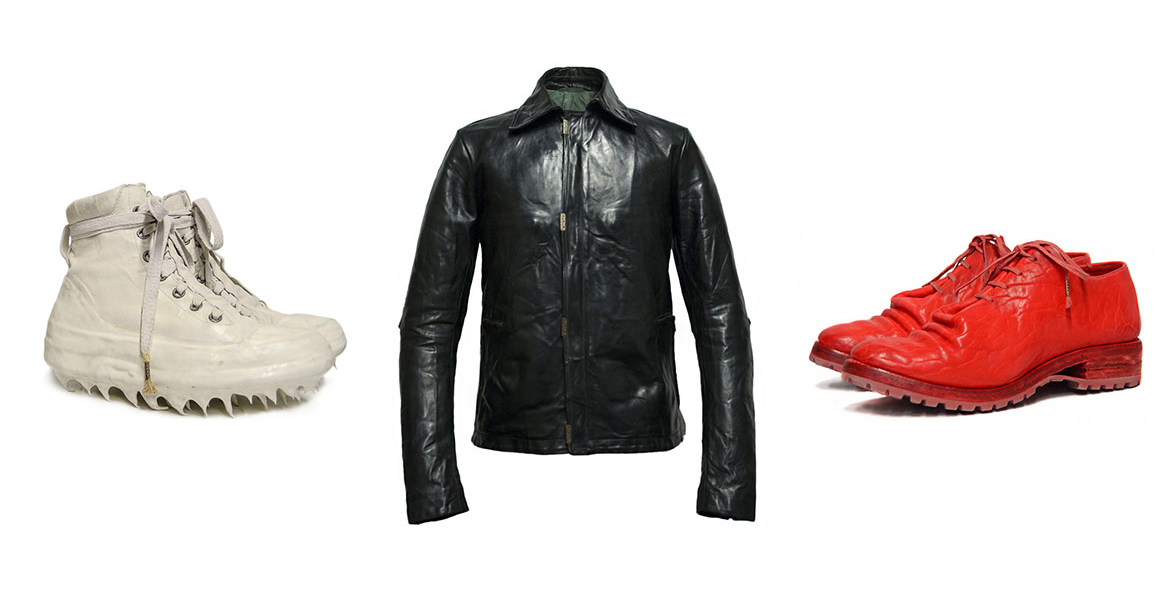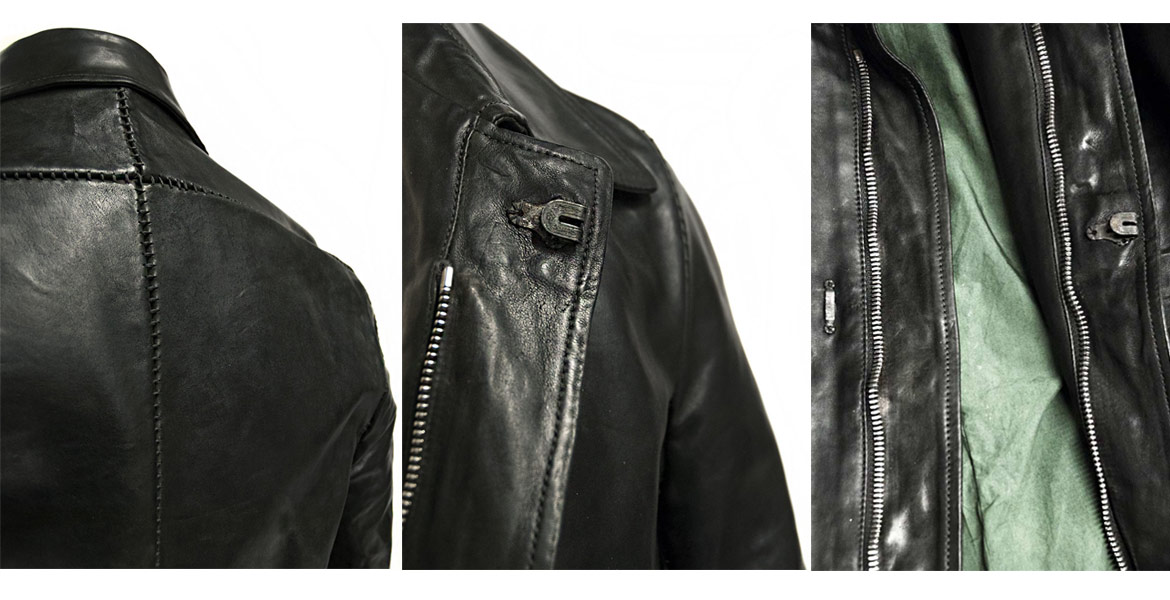Carol Christian Poell online guide for CCP leather shoes and garments

- A short guide to all kinds of leather used by Carol Christian Poell in his items such as boots and jackets.
The Austrian designer Carol Christian Poell (CCP) is famous for his eccentric creations and for the bold use of different materials and technologies in the creation of his fashion collections.
Precious leathers are among his favorite materials: horse leather, calf leather, kangaroo leather, bison leather, ... Already from the identification code of each CCP garment you can recognize the type of leather used for that product, as well as the model and color. For example, if the code of a Carol Christian Poell leather jacket is LM/2498 CORS-PTC/12, the first code and subsequent digit identify the model (LM/2498), the sequence of central letters the material of which it’s made ( CORS-PTC), the final figure is the color (12).
To recognize the type of leather of which a CCP garment is made, the central part of the product identification code must therefore be considered. Below we propose a list of the codes used by the brand CCP to define the leather used:
Leather for CCP clothing:
- BIAS-PTC bison leather, both with wet white and with vegetable tanning;
- CORS-PTC horse leather from fore-part of the body, both with wet white and with vegetable tanning;
- CORSS-PTC thicker horse leather from fore-part of the body, both with wet white and with vegetable tanning;
- ROOLS-PTC kangaroo thin leather, thickness mm. 0,4-0,5, both with wet white and with vegetable tanning;
- ROOMS-PTC kangaroo thicker leather, mm. 0,8-0,9, both with wet white and with vegetable tanning.
Leather for CCP footwear:
- BIAS-PTC thin bison leather, used also in clothing items, both with wet white and with vegetable tanning;
- BIUS-PTC bison leather thicker than the one above, used only for footwear, both with wet white and with vegetable tanning;
- BUUS-PTC thicker bison leather die-cut with short cuts in a regular designed pattern, used only for footwear, both with wet white and with vegetable tanning;
- CUBS-PTC cordovan horse leather in wet white tanning, used only on the reversed side (the side with the calluses);
- CUL-PTC cordovan horse leather in vegetable tanning, used on the reversed side (the side with the calluses) and for very dark colors, such as black code 10 or dark green code 12;
- SBUC-PTC cordovan horse leather in wet white tanning, used on the full grains side;
- LUC-PTC cordovan in vegetable tanning, used on the full grains side and for very dark colors, such as black code 10 or dark green code 12;
- CORS-PTC horse leather from fore-part of the body, both with wet white and with vegetable tanning, used for some footwear items but few clothing items too;
- ROOMS-PTC kangaroo leather, used also for clothing items, both with wet white and with vegetable tanning;
- RUUMS-PTC kangaroo leather die-cut with short cuts in a regular designed pattern, used only for footwear, both with wet white tanning and with vegetable tanning.
- PACAL-PTC calf leather paired with a polythene material that's similar to paper, which unlike paper, has no traction resistance, so during the pairing with the leather in some points, such as the toecap of the shoes, it creates some small rips which are unique and peculiar for every item.

Among the leathers chosen by CCP for its collections there is the cordovan leather (cordovan shoes, cordovan boots,...), one of the finest handcrafted leathers. Also called "Moroccan", the cordovan is equine leather, obtained from the back of the horse (the so-called "breech"). It owes its name to the Spanish city of Cordoba, historically the European heart of leather tanning.
Given the difficulty in applying dyes, the range of colors available is limited: the most common color of cordovan is bordeaux, but there is no lack of darker and neutral shades.The horse leather is dyed manually inside it, therefore on the contrary compared to other types of leather. After ten days, the greasing phase is followed, followed by the polishing phase, with a crystal or agate roller.
The manufacturing process lasts a total of six months but the result is a product of the highest quality and value. It is no coincidence that the distinctive feature of cordovan is its luster, due to the long and meticulous craftsmanship of the raw material: the horse leather will always be shiny, long-lasting and scratch-resistant, even after years of use.
The garments in cordovan by Carol Christian Poell are identified by a double code produced according to the side of the leather used: "CUL-PTC" in the case of the reverse side of the tanning, if it's spelled backwards as "LUC-PTC" is the case of the so-called full grain or skin side of the leather. On the full grain side you can see sometimes small scars gotten by the animal during its natural lifetime. As CCP writes for every item the presence of irregularities on the surface or on the colour is due to the peculiarity of each single skin, in this way every product is unique.
What does -PTC stand for?
Most of leather materials by CCP has -PTC in their name which stands for "Pronto per tintura in capo" meaning ready to be garment-dyed.
Carol Christian Poell first constructs his products and then dyes them in a barrel, whilst most industrialized manufacturers prefer to paint on the material before making the garment or the shoes. Dyeing in a barrel is a complicated and artisanal procedure which leads to unpredictable results in terms of color tones, shades and shrinking, it's also very time consuming and final dry out and polishing have to be done by hand.
Some rare items may have -PCC in their leather material code, it stands for "Pronto per concia in capo" which means ready to be garment-tanned, those are constructed even before the tanning treatment.
What about Carol Christian Poell colors?
Here you can find a list of the most used color codes used by CCP to dye leather:
- 01 bright white
- 03 natural white/pale pink
- 06 light green
- 10 or 010 or 1010 black
- 12 dark green
- 13 red
- 14A orange
- 15 dark violet red
- 16 electric blue/purple
- 19 dark grey
- 29 extremely dark blue
- 33 light grey
- 35 yellow
Each color code corresponds to a different dyeing formula, for example 10 is the black dye used for fabric, 010 is the black dye mostly used on leather.
